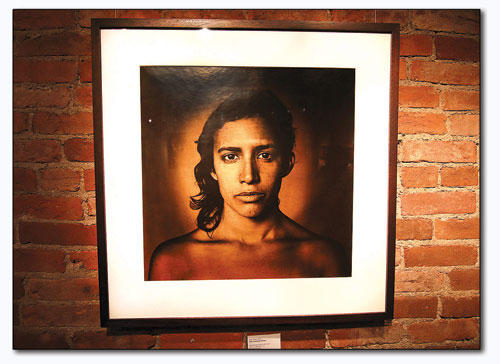
 |
|
Guatemalan photographer Luis González Palma’s photograph “Maria Paula, 2008,” is one of several on display at the Open Shutter Gallery. His “Variations” |
Windows to the soul
Acclaimed Guatemalan photographer featured at Open Shutter
by Stew Mosberg
Spiritual, dramatic, haunting, intense are all words that can be used to describe the photographs of internationally acclaimed photographer Luis Gonzáles Palma. Still, above all, artistic is the adjective that most comes to mind when describing his current solo exhibit, “Variations,” at the Open Shutter Gallery.
JusttheFactsWhat: “Variations,” a show by renowned Guatemalan photographer Luis Gonzáles Palma |
The Guatemalan born Gonzáles Palma’s expansive body of work began almost 30 years ago. Forsaking a career as an architect, he turned to photography, creating a series of hand-painted photographs of native Mayans that evoked the stuff of dreams. It is a theme he has repeated throughout his preferred profession.
No idle choice, Gonzáles Palma takes great pride in his own Guatemalan and indigenous roots. As evidenced in the 22 photos on display at Open Shutter, he continues to portray the pain and sorrow of a once great civilization through the eyes of its survivors. His close-up portraits of exquisite aboriginal women are both captivating and startling. His signature portraits are most often printed in sepia-tone while the subjects’ eyes are left their natural white. The effect is piercing; for both viewer and model. The women do not smile, nor do they entreat, yet they speak volumes in their silence.
All the photos in the “Variations” exhibit are arresting, many incorporate collage elements and superimpose Latin American and European symbols. Each implies a mysterious story, something haunting, something revealed and something hidden; the ambiguity is in the eyes. In them, one senses a longing and knowingness contrasted with loss.
The artist employs a range of alternative processes including gold leaf and resin with Kodalith print; gelatin silver processing; and, in some cases, adding hard-edged acrylic paint that slashes across the surface.
Gonzáles Palma took his inspiration from the poetry and art of the 1960s Brazilian movement known as Neo-Concreatism. According to South American artist Lygia Clark, it sought to “decipher the nature of humanity by creating a medium of expression, which allowed people to become aware of unity as an organic, living whole.”
Open Shutter Manager Arista Slater serendipitously studied with Gonzáles Palma when she was a student in Boston and suggested him to Open Shutter owner Margy Dudley. It wasn’t long before the artist himself responded favorably, and Open Shutter worked through a gallery representative in Arizona to pull the show together.
The pieces on view vary in size, some as large as 32-by-52 inches, such as the embroidered brocade collage-photograph entitled “Miedo, Nausea, Deseo,” which can be loosely translated to mean, “Fear, Nausea, I wish.” A peculiar title perhaps, but the combination of imagery incorporates a picture of the Virgin Mary and Jesus in embroidered brocade and sepia-tone portraiture, and is as ambiguous a choice of imagery as is the title.
Arguably the most fascinating piece is one that remains mostly hidden with only a hint of its surface peeking out. It is a large roll of felt that has been imprinted with a photo and impaled with red thread. It is part of a previously exhibited series “Mobius,” a term for a configuration that has no beginning or end. In Mobius, the photographer produced close-up images of native Guatemalans entwined with history; their gazes meeting the viewer head-on with a dignity that is equally weighted with frailty and sorrow.
 Luis González Palma’s “Escena 10, Loteria 3 (Scene 10, lottery 3), 2011.”/ ./Photo by Jennaye Derge |
In the Open Shutter exhibition there is an image without human subject called “As a secret, he seduces himself.” The title is somewhat elusive, but might allude to the foreshortened brass bed in the center of the photo. The visual metaphor reflects a moodiness as well as emptiness, conjuring something beyond the present, implying an unspoken occurrence. It places the burden on viewers to consider their own personal story.
Several images in “Variations” are produced on engraved glass; many also incorporate the aforementioned gold leaf, sometimes as minute detail and other times in full sheets as in “Nacimiento,” one of the larger pieces in the show.
Of her close encounter with Gonzáles Palma, Slater said he left a deep impression on her and that he often spoke of poetry, a reflection of his Neo-Concreatism roots, but also of the sadness and pain of his marginalized people. She remarked that the gaze of his portraits are an attempt to level the “playing field” between viewer and subject. Her most poignant memories of the photographer were his sincerity and intensity, and she was profoundly influenced by the beauty he found in the sadness of his subjects.
If the photographs seem vaguely familiar it may be because Gonzáles Palma’s artistry was used as a backdrop for John Sayle’s 1997 film, “Men with Guns,” a story that takes place in Latin America as told by an Indian woman to her daughter.
Visitors to the Open Shutter will have the opportunity to see one of the best Latin American photographers working today, a peer of the renowned Sebastian Salgado. Both artists portray suffering, Salgado generally on a larger scale, while Gonzáles Palma does it on an individual, more personal level. “Variations” is worth revisiting; engaging each image as an intimate eye-to-eye experience, to delve into the mystery behind the stare, to find meaning in the obfuscation, and to look into one’s own soul.
